Banchan
Banchan (/ˈbɑːnˌtʃɑːn/,[1] from Korean: 반찬; 飯饌; banchan [pan.tɕʰan]) or bansang is a collective name for small side dishes served along with cooked rice in Korean cuisine. As the Korean language does not distinguish between singular and plural grammatically, the word is used for both one such dish or all of them combined.
| Banchan | |
 | |
| Korean name | |
|---|---|
| Hangul | 반찬 |
| Hanja | 飯饌 |
| Revised Romanization | banchan |
| McCune–Reischauer | panch'an |
| IPA | [pan.tɕʰan] |
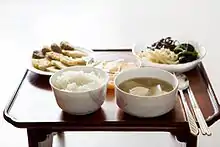 |
| This article is part of a series on |
| Korean cuisine 한국 요리 조선 료리 |
|---|
The basic table setting for a meal called bansang (반상) usually consists of bap (밥, cooked rice), guk or tang (soup), gochujang or ganjang, jjigae, and kimchi. According to the number of banchan added, the table setting is called 3 cheop (삼첩), 5 cheop (오첩), 7 cheop (칠첩), 9 cheop (구첩), 12 cheop (십이첩) bansang, with the 12 cheop used in Korean royal cuisine.[2]
Banchan are set in the middle of the table to be shared. At the center of the table is the secondary main course, such as galbi or bulgogi, and a shared pot of jjigae. Bowls of cooked rice and guk (soup) are set individually. Banchan are served in small portions, meant to be finished at each meal and are replenished during the meal if not enough. Usually, the more formal the meals are, the more banchan there will be. Jeolla province is particularly famous for serving many different varieties of banchan in a single meal.[3]
While the countries surrounding Korea were preserving foods with their abundance of livestock resources. Korea was forced to utilize another way to safeguard their resources. Due to their focus on agriculture; the main ingredients in their fermented foods were grains and vegetables. [4] The fermentation process is necessary as most parts of the Korean peninsula are isolated by mountains from all sides. Additionally, this process of fermentation can be used to enrich the flavor profile of food with the use of gochujang. [5] Kimchi is a perfect example of this enriched food utilizing the flavor and fermentation process together. Therefore, ‘Banchan is mainly seasoned with fermented soy products, medicinal herbs, and sesame or perilla oils’ (Kim et al., 2016). [6]
Gochujang was added to enhance each meal. Potentially, this could refer to another chojang (vinegar sauce) that was used as a dipping sauce. [7] ‘Mustard was an additional important seasoning used to enrich the flavor of the foods. Chojang was made by mixing gochujang with honey, vinegar, and ground pine nuts’ (Chung et al., 2017). ‘It was made by adding mustard powder or whole mustard to water and grinding it out, then adding vinegar, salt and sugar and leaving the mixture upside down in a warm place’ (Chung et al., 2017).
For the fermentation of vegetables jangkwa (pickled vegetables and fruit) were served. These dishes were created by pickling the different seasonal vegetables with kanjang, gochujang, and doenjang. [8] ‘However, in the palace, jangkwa also referred to a dish made by pickling cucumber, radish, young radish, parsley, or cabbage heart with salt then drying it in the sun, removing all moisture, and the vegetables were stir-fried with beef, shredded red pepper, sesame oil, and sesame and salt’ (Chung et al., 2017).
History
Banchan is thought to be a result of Buddhist influence at around the mid-Three Kingdoms period and the subsequent proscription against eating meat by the monarchies of these kingdoms.[9] Thus, with the ban on meat-containing dishes, vegetable-based dishes rose in prominence and became the focal point of Korean cuisine;[9] court kitchens developed various methods for cooking, preparing and presenting these dishes, while less-affluent commoners produced smaller, simpler arrays of these vegetable-based dishes.[9]
Although the Mongol invasions of Korea ended the ban on meat-containing dishes, as well as meat offerings for rituals such as jesa, approximately six centuries of vegetable-based cuisine in the form of banchan had imprinted itself into Korean cuisine.[9]
During the Chosun Dynasty, Buddhism was shunned while Confucianism remained the dominant ideology that was followed. Tea was no longer served in the palace and slowly began to dwindle, however, the ceremony of tea and rice cakes as snacks endured. Through food, the Chosun kings were able to see the living conditions of their people. [10] ‘Accordingly, royal cuisine in the final period of the Chosun Dynasty was borne out of a culture of restraint based on Confucian ideology, but experienced changes after the 18th century as taste and personal preference became more dominant values’ (Chung et al., 2017). ‘The Korean Empire was also influenced by foreign cuisine, and western-style banquets were held in Deoksugung (德壽宮) Palace. King Kojong is known to have been a fan of coffee. As Emperor Sunjong took the throne, royal cuisine was introduced to the common people through royal chefs and cooks’ (Chung et al., 2017).
Varieties
Kimchi
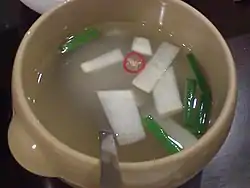
Kimchi is fermented vegetables, usually baechu (Napa cabbage), seasoned with chili peppers and salt. This is the essential banchan of a standard Korean meal. Some Koreans do not consider a meal complete without kimchi. Kimchi can be made with other vegetables as well, including scallions, gat (갓), and radish (무; mu).
| Name[11] | Korean name | Description |
|---|---|---|
| Nabak-kimchi | 나박김치 | Watery kimchi with less spicy baechu and mu |
| Dongchimi | 동치미 | Various vegetables in white brine. Nabak kimchi and dongchimi are referred to as mul kimchi (물김치), literally "water kimchi." |
| Geotjeori[12] | 겉절이 | Freshly made kimchi to be eaten crisp without fermenting. Usually made with baechu and lettuce. |
| Kkakdugi | 깍두기 | A kimchi made with cubed mu (white radish) |
| Oi sobagi | 오이 소박이 | Stuffed cucumbers kimchi, stuffed with chili, spring onions and buchu |
| Chonggak kimchi | 총각김치 | Whole mu with chili pepper seasoning. It is made with dallangmu, about the same size as sausages. |
| Yeolmu-kimchi | 열무김치 | Thin and small young summer radish kimchi, which can be prepared either with or without fermented jeotgal. |
| Pa kimchi | 파김치 | Hot and salty scallion kimchi, seasoned with much myeolchijeot, the Korean version of salted anchovies. |
| Gat kimchi | 갓김치 | Indian mustard leaf kimchi with a large amount of red pepper powder and the unique bitter taste and aroma. Strong myeolchijeot and glutinous rice paste are added to reduce the hot and bitter taste.[13] |
Namul
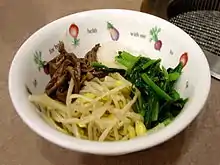
Namul (나물) refers to steamed, marinated, or stir-fried vegetables usually seasoned with sesame oil, salt, vinegar, minced garlic, chopped green onions, dried chili peppers, and soy sauce.
| Name[14][15] | Korean name | Description |
|---|---|---|
| Kongnamul | 콩나물 | Cold boiled bean sprouts with sesame oil. |
| Sigeumchi namul[16] | 시금치나물 | Lightly parboiled spinach dressed with sesame oil, garlic, and soy sauce. |
| Miyeok muchim[17] | 미역무침 | Miyeok (wakame, a seaweed) with sweet vinegar and salt. |
| Musaengchae/Muchae[18] | 무생채/무채 | Long julienned white radish in a sweet vinegar sauce, sometimes with ground dried chili peppers. |
| Gosari namul | 고사리나물 | Prepared fern shoots that have been stir-fried. |
| Chwinamul | 취나물 | Stir-fried and seasoned aster scaber. |
| Bireum namul[19] | 비름나물 | Parboiled and seasoned amaranthus. |
| Naengi namul[20] | 냉이나물 | Parboiled and seasoned shepherd's purse. |
| Dolnamul | 돌나물 | Raw Sedum with pepper sauce dressing. |
| Gogumasun namul[21] | 고구마순나물 | Boiled/seasoned sweet potato shoots. |
| Gaji namul | 가지나물 | Boiled eggplant. |
| Doraji namul | 도라지나물 | Boiled Chinese bellflower roots. |
Bokkeum
Bokkeum (볶음) is a dish stir-fried with sauce.
- Kimchi bokkeum (김치볶음) - Stir-fried kimchi, often with pork[22] (similar to jeyook bokkeum).
- Jeyook bokkeum (제육볶음) - Stir-fried pork with gochujang (chili pepper paste) sauce and onions.[23]
- Ojingeochae bokkeum (오징어채볶음) — Stir-fried dried shredded squid seasoned with a mixture of gochujang (chili pepper paste), garlic, and mullyeot (syrup-like condiment).[24]
- Nakji bokkeum (낙지볶음) - Stir-fried baby octopus in spicy gochujang sauce.[22]
- Buseot bokkeum (버섯볶음) - Stir-fried mushrooms such as pyogo, oyster mushrooms, pine mushrooms.[22]
Jorim
Jorim is a dish simmered in a seasoned broth.
Jjim
Jjim is a steamed dish.
- Gyeran-jjim (계란찜) — Mixed and seasoned eggs steamed in a hot pot.[27]
- Saengseon jjim (생선찜)- Steamed fish.[28]
Jeon
Jeon denotes a variety of pan-fried, pancake-like dishes.[29] Buchimgae is a near synonym.
- Pajeon (파전) — Thin pancakes with scallions.[29]
- Kimchijeon (김치전) — Thin pancakes with old (ripe) Kimchi.[29]
- Gamjajeon (감자전) — Korean-style potato pancakes.[30]
- Saengseon-jeon (생선전) — Small portions of fish coated with eggs and pan-fried.[31]
- Donggeurang ttaeng (동그랑땡) — Patty made with tofu, meat and vegetables, coated with eggs and pan-fried.[32]
Others
- Danmuji (단무지) — A pickled radish marinated in a natural yellow dye made from gardenia fruit.
- Gyeran-mari (계란말이) — A rolled omelet served in slices.
- Japchae (잡채) — A stand-alone dish in its own right, japchae can also be eaten as banchan. Japchae is glass noodles accompanied with a variety of vegetables and beef in a slightly-sweet garlic sauce.
- Korean-style potato salad (감자 샐러드) with apples and carrots.
Gallery
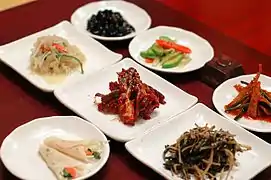 Various banchan served at a table
Various banchan served at a table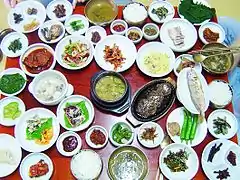 Table setting in Jeolla province with many banchan
Table setting in Jeolla province with many banchan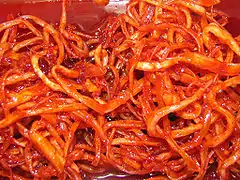 Ojingeochae bokkeum (오징어채볶음)
Ojingeochae bokkeum (오징어채볶음) Yeongeun jorim (연근조림)
Yeongeun jorim (연근조림)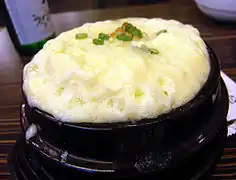 Gyeran jjim (계란찜) in a hot pot
Gyeran jjim (계란찜) in a hot pot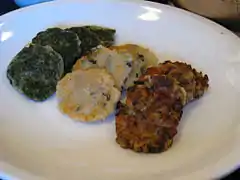 Samsaek jeon (삼색전), any three different colored jeon are referred to as such.
Samsaek jeon (삼색전), any three different colored jeon are referred to as such.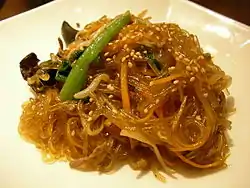
See also
References
- Bhandari, Aparita (22 March 2017). "Learning how to eat banchan". Toronto Star. Retrieved 15 April 2017.
- (in Korean) Making a bansang from Doosan Encyclopedia
- (in Korean) Hanjeongsik from Naver open dictionary, food columnist Lee JinRang (이진랑), 2005-07-17
- Kim, Soon Hee; Kim, Myung Sunny; Lee, Myoung Sook; Park, Yong Soon; Lee, Hae Jeong; Kang, Soon-ah; Lee, Hyun Sook; Lee, Kyung-Eun; Yang, Hye Jeong; Kim, Min Jung; Lee, Young-Eun; Kwon, Dae Young (2016). "Korean diet: Characteristics and historical background". Journal of Ethnic Foods. 3: 26–31. doi:10.1016/j.jef.2016.03.002.
- Kim, Soon Hee; Kim, Myung Sunny; Lee, Myoung Sook; Park, Yong Soon; Lee, Hae Jeong; Kang, Soon-ah; Lee, Hyun Sook; Lee, Kyung-Eun; Yang, Hye Jeong; Kim, Min Jung; Lee, Young-Eun; Kwon, Dae Young (2016). "Korean diet: Characteristics and historical background". Journal of Ethnic Foods. 3: 26–31. doi:10.1016/j.jef.2016.03.002.
- Kim, Soon Hee; Kim, Myung Sunny; Lee, Myoung Sook; Park, Yong Soon; Lee, Hae Jeong; Kang, Soon-ah; Lee, Hyun Sook; Lee, Kyung-Eun; Yang, Hye Jeong; Kim, Min Jung; Lee, Young-Eun; Kwon, Dae Young (2016). "Korean diet: Characteristics and historical background". Journal of Ethnic Foods. 3: 26–31. doi:10.1016/j.jef.2016.03.002.
- Chung, Hae-Kyung; Shin, Dayeon; Chung, Kyung Rhan; Choi, Soe Yeon; Woo, Nariyah (2017). "Recovering the royal cuisine in Chosun Dynasty and its esthetics". Journal of Ethnic Foods. 4 (4): 242–253. doi:10.1016/j.jef.2017.12.001.
- Chung, Hae-Kyung; Shin, Dayeon; Chung, Kyung Rhan; Choi, Soe Yeon; Woo, Nariyah (2017). "Recovering the royal cuisine in Chosun Dynasty and its esthetics". Journal of Ethnic Foods. 4 (4): 242–253. doi:10.1016/j.jef.2017.12.001.
- "About Banchan". Hannaone. Archived from the original on 18 May 2010.
- Chung, Hae-Kyung; Shin, Dayeon; Chung, Kyung Rhan; Choi, Soe Yeon; Woo, Nariyah (2017). "Recovering the royal cuisine in Chosun Dynasty and its esthetics". Journal of Ethnic Foods. 4 (4): 242–253. doi:10.1016/j.jef.2017.12.001.
- "Types of Kimchi". Korea Tourism Organization. Archived from the original on 5 January 2013. Retrieved 4 April 2013.
- 겉절이 (in Korean). Doosan Encyclopedia. Retrieved 4 April 2013.
- Types of kimchi Archived 2010-02-07 at the Wayback Machine from Kimchi Time
- "Korean Food: Seasoned Vegetables". Life in Korea. Retrieved 4 April 2013.
- Chung, Suzy (10 April 2012). "Herbivore's delight – Spring namul". Korea.net. Archived from the original on 30 April 2013.
- "Spinach Side Dish Sigeumchi Namul (시금치나물)". Maangcshi.com. Retrieved 4 April 2013.
- Sook Choe Ji, Yukiko Moriyama (2003). Quick and Easy Korean Cooking for Everyone. Japan Publications Trading. p. 42. ISBN 9784889961249.
- 무생채 (in Korean). Doosan Encyclopedia. Retrieved 4 April 2013.
- 비름나물 고추장무침 (in Korean). Allrecipes.kr. Archived from the original on 5 October 2013. Retrieved 4 April 2013.
- "Naengi namul (shepherd's purse namul)". Sanchon. Retrieved 4 April 2013.
- "Gogumasun namul". Trifood. Retrieved 4 April 2013.
- "Stir-fried dishes". Life in Korea. Archived from the original on 9 March 2013. Retrieved 4 April 2013.
- "JAE-YOOK (KIM-CHI) BO-KUM". Trifood. Retrieved 4 April 2013.
- 오징어채볶음 (in Korean). Doosan Encyclopedia. Retrieved 4 April 2013.
- "두부조림(dubu jorim / Braised Pan-Fried Tofu)" (in Korean). Doosan Encyclopedia. Retrieved 4 April 2013.
- "JANG-JO-RIM". Trifood. Retrieved 4 April 2013.
- 계란찜 (in Korean). Sports Khan. 13 March 2013. Retrieved 5 April 2013.
- "Saengseon Jjim Braised Fish With Radish in Seasoned Soy Sauce". The Korea Times. 7 January 2010. Retrieved 5 April 2013.
- "A List of Korean Savory Pancakes". About.com. Retrieved 5 April 2013.
- 감자전 (in Korean). Donga. Archived from the original on 27 February 2004. Retrieved 5 April 2013.
- "Saengseon Jeon (Pan-Grilled Fish With Egg)". Korea Timea. 10 December 2009. Retrieved 5 April 2013.
- 동그랑땡 (in Korean). Donga Woman. 2006. Retrieved 5 April 2013.
External links
| Wikimedia Commons has media related to Banchan. |
| Look up 반찬 in Wiktionary, the free dictionary. |